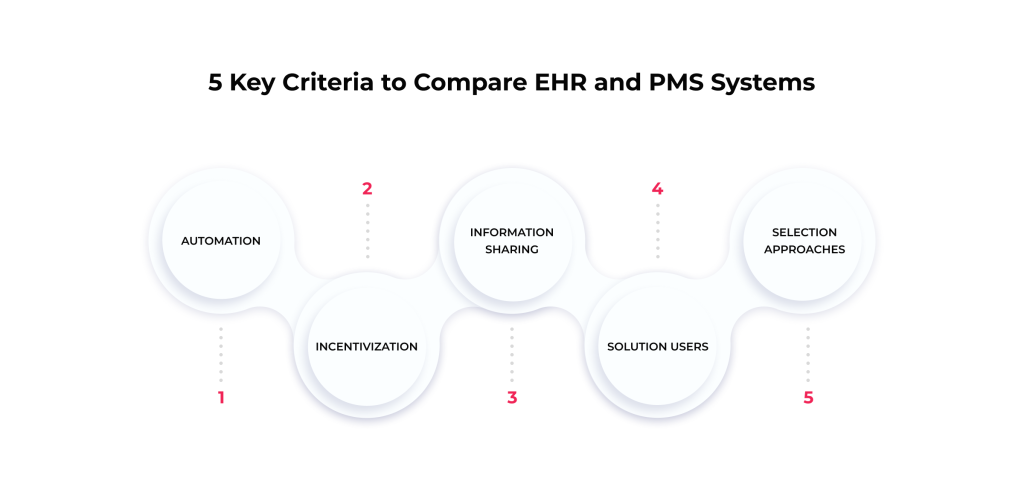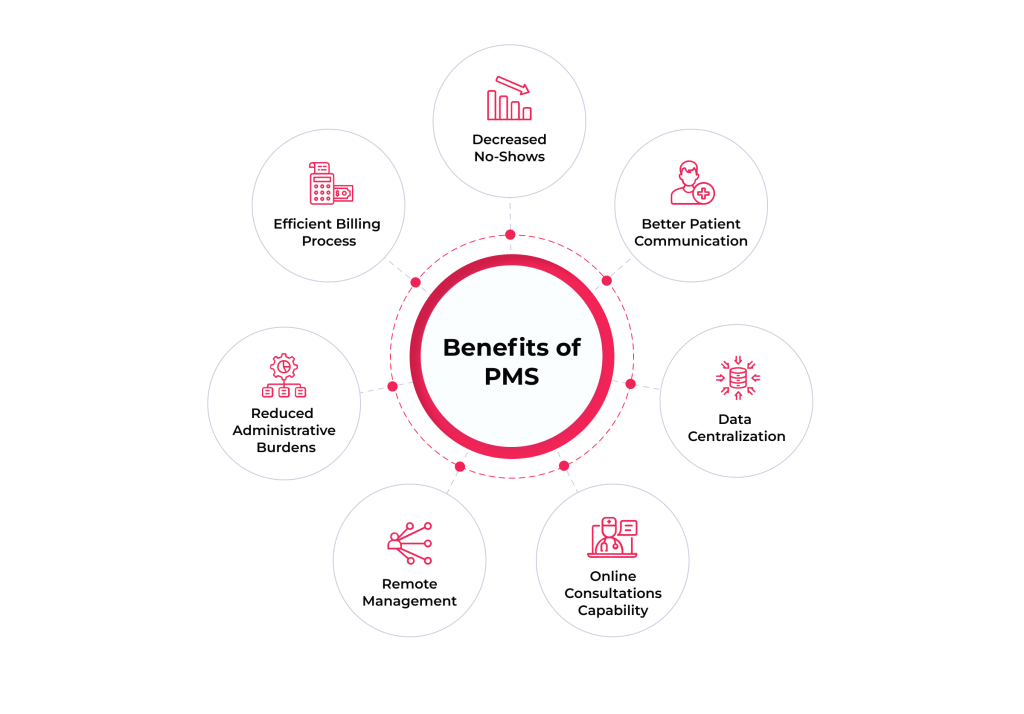Today, electronic health record (EHR) software is predominantly used by clinical staff, such as doctors, nurses, and other medical professionals. Simultaneously, practice management software (PMS) is software designed for utilization by practice administrators and support personnel, which often includes receptionists, billing experts, and office coordinators.
The Black Book Market Research shows that 98% of U.S. physicians implement EHR software, whereas 87% of healthcare administrators employ PMS tools. This trend confirms that an EHR system is vital for modern patient care. However, with the evolution of healthcare tech, EHR software providers have recognized the benefits of incorporating PMS solutions into their offerings. This integration enhances the efficiency of administrative tasks and ensures seamless management of clinical operations within healthcare organizations and clinics.

Although many medical practice setups can operate effectively without an integrated PMS system, essential reasons exist for combining EHR and practice management software functionalities. Below, we will explore the nature of both solutions by analyzing their critical differences and determining whether combining them will be effective for your medical practice.
Table of Contents
“At SPsoft, our commitment to advancing healthcare through technology has driven us to develop top-tier EHR and practice management solutions. With years of experience, we’ve mastered the integration of clinical precision and administrative efficiency, helping healthcare providers offer exceptional patient care while optimizing operational workflows. Our solutions are designed with the user in mind, ensuring that our clients receive user-friendly, powerful, and transformative software that puts the practice at your fingertips.“
Mike Lazor
CEO, SPsoft
“Our team at SPsoft is dedicated to enhancing how healthcare facilities operate. We recognize the unique challenges medical professionals face, which is why our EHR and practice management solution is crafted to streamline processes and improve patient outcomes. By combining robust functionality with intuitive EHR design, we ensure our solutions meet the needs of today’s dynamic healthcare environment and improve clinical workflows.“
Romaniya Mykyta
Head of Product Management, SPsoft
The Core Functions of EHR and PMS
To choose the best EHR software for your organization, it is essential to first understand the core functions of each system.
Key Reasons to Use an EHR System
Electronic health records are the electronic counterpart of a patient’s medical chart, covering their comprehensive health history and medical information. This tech is among the most prevalent medical practice software solutions today. EHRs offer numerous features to support patient care, including:
- Clinical Documentation. Document management capabilities, enabling the creation and digital storage of patients’ clinical records and charts. The EHR platform ensures the accuracy of clinical documentation.
- Medication Tracking. Allows for monitoring patient prescriptions with ease, helping assess potential medication interactions and record allergic reactions.
- E-Prescribing. Allows practices to issue electronic prescriptions that patients can send directly to a pharmacy.
- Customizable Templates. Customizable consultation templates that simplify the charting process and ensure patient data is easily accessible.
- Reporting Tools. Automate the generation of reports from the EHR software using collected data, such as patient histories, lab results, or other documents.
These are the most compelling reasons for the widespread use of EHR management solutions in primary care and specialized settings.
Ready to find the perfect software solution for your medical practice? Contact us today to explore the differences between EHR and practice management and discover which one aligns best with your goals!
Key Reasons to Use Practice Management Software (PMS)
Practice management solutions are digital platforms developed to manage all the administrative tasks essential for a medical practice’s smooth operation. This includes automatically tracking medical supplies and handling the revenue cycle management (RCM).
Key features of practice management software that facilitate healthcare operations include:
- Patient Portal. Enables patients to schedule appointments online, access lab results, and communicate with their doctors, significantly enhancing patient experience.
- Billing and RCM. Automated medical billing systems generate invoices, track claims, and manage the full revenue cycle management (RCM). This feature, often handled by robust billing software, is central to a modern medical facility.
- Scheduling Capabilities. Tools that allow for easy adjustments and viewing of staff and patient schedules in a centralized location. Effective scheduling is key to practice automation.
- Inventory Management. Tools that maintain an accurate count of items and notify when restocking is needed.
- Patient Management (CRM). Medical CRM systems track each patient visit interaction, enhancing patient experiences and supporting effective digital marketing strategies.
Practice management software offers great relief from laborious manual tasks, helping streamline healthcare operations. This is particularly beneficial for smaller medical practices aiming to cut administrative costs and expanding organizations looking to grow and handle more patients.
EHR vs. PMS: The Critical Differences
Recognizing the following fact grasps the distinction between EHR and practice management: while practice management focuses on a healthcare facility’s daily administrative activities, EHRs center primarily on patient-specific data, with limited overlap.

Difference №1. The Focus of Automation
Practice management and EHR systems heavily utilize automation to streamline various tasks. PMS tools automate routine tasks like scheduling work and setting appointments. At the same time, they enable the storage and reuse of patient data like names, demographics, insurance details, and contact information. EHRs, on the other hand, allow healthcare providers to detect health patterns, identify allergies, and predict potential diseases, supporting clinical workflows.
Such a capability to collect patient data once and then utilize it repeatedly eliminates the need for repetitive information entry with each visit. That frees administrative staff to focus on more critical tasks and reduces the reliance on manual, handwritten documentation.
Difference №2. Financial Incentivization
In contrast to PMS platforms, the government incentivizes the adoption of an electronic health records system to enhance the overall quality of care. Healthcare providers can receive substantial financial investments for implementing an EHR system in their medical practice.
These incentives, which can substantially enhance a facility’s financial performance due to EHR project management adoption, are a promising benefit. Besides, the system’s use varies among different roles within a healthcare setting. For instance, a doctor may require complex access to a patient’s medical history and health insurance information. However, a typical front desk staff member does not. That highlights possible financial gains and the system’s adaptability, instilling a sense of optimism about the investment in an EHR project management solution.
Difference №3. Information Sharing and Health Information Management
While the data managed by PMS software is traditionally tailored to a clinic and does not need widespread sharing, EHR systems enable broader data sharing. That facilitates better decision-making and more comprehensive treatment discussions. EHR solutions allow physicians, staff, patients, and other organizations to exchange crucial documents containing health information.
Difference №4. Solution Users
Office managers and receptionists primarily utilize practice management systems, focusing on the billing and scheduling aspect of the clinical and financial workflow. In contrast, medical professionals like doctors, dentists, and nurses are the primary users of EHR platforms. Thus, integrated EHR practice management tools are vital to managing schedules efficiently, accommodating more patients, and enhancing productivity.
Specialty-Specific Needs for EHR Solutions
Choosing the right EHR system depends heavily on your medical specialty. A solution that works for a general primary care setting may not suffice for a niche clinic. EHR is built with different specialty needs in mind.
- Ambulatory Care. For ambulatory facilities and outpatient clinics, the EHR system must focus on rapid check-in/out, strong integration with diagnostic labs, and efficient billing. The best EHR software for this setting often needs to be scalable.
- Behavioral Health. For behavioral health professionals and wellness professionals, the EHR often requires specialized features like group schedules, customizable progress notes, and secure patient questionnaires. Vendors like SimplePractice or DrChrono often focus on these niches.
- Direct Primary Care (DPC). Direct primary care models need features that support subscription billing, secure patient messaging, and integrated telehealth capabilities — often best supported by a cloud-based EHR.
Leading EHR and integrated EHR vendors like athenahealth, eClinicalWorks, Veradigm (formerly Allscripts), and NextGen Healthcare offer specialty templates to help practices address these unique demands.
Transform your medical practice with SPsoft’s developed EHR solutions. Leverage our extensive experience crafting robust, intuitive, and fully integrated EHR systems to enhance patient care!
Which One to Choose: EHR or Practice Management Software
Practice management and EHR platforms represent two fundamental aspects of healthcare management. While the primary focus is ensuring that patients receive optimal patient care, a medical practice also requires effective administration and financial management to thrive.
Therefore, you can implement EHR management and PMS in your medical practice to balance clinical excellence and operational efficiency. If budget constraints limit your ability to invest in both EHR solutions, consider the pros and cons of each.
EHR Advantages
The key advantages of using EHR project management software include:

- Enhanced Accuracy. EHRs help reduce medical errors by maintaining updated patient information, which supports precise diagnosis and treatment.
- Reduced Redundancy. EHR platforms provide quick access to lab results, which reduces the necessity for duplicate testing.
- Increased Patient Engagement. They enable patients to access their medical records, promoting active participation in their healthcare.
- Efficiency in Record-Keeping. Digital storage of records saves time and physical space, helping to streamline the workflow.
- Constant Monitoring. EHRs keep comprehensive records accessible for ongoing reference, allowing for patient data tracking over time.
- Preventative Health Management. By identifying patients due for screenings, EHR solutions enhance the delivery of preventive care.
- Improved Security and Privacy. Digital records are protected with robust cybersecurity measures, improving the privacy and security of patient information.
- Cost Reduction. EHRs can lower operational costs by minimizing the need for physical storage and easing the workload on administrative staff.
- Support for Research Activities. They facilitate health research by systematically documenting health information.
EHR Disadvantages
The key disadvantages of utilizing EHRs cover:
- High Initial Costs. Implementing EHR platforms can be costly due to the need for appropriate hardware, training, and ongoing support alongside the software.
- Risk of System Failures. Malfunctions may occur, potentially leading to system downtime or data loss.
- Security Risks. Despite improvements, there is still the risk of data breaches if adequate security measures are not implemented effectively.
PMS Advantages
The most crucial benefits of adopting practice management software are the following:

- Reduced Administrative Burdens. PMS helps streamline administrative tasks such as scheduling patient appointments, calculating employee salaries, and saving time.
- Efficient Billing Process. It automates medical billing, generating invoices and tracking claims to facilitate quicker transactions.
- Decreased No-Shows. Automated reminders help reduce patient no-shows by reminding patients of their appointments.
- Better Patient Communication. PMS tools support the creation of targeted marketing strategies, improving patient communication.
- Data Centralization. All patient management, revenue cycle management, and medical information are centralized in one system.
- Online Consultations Capability. PMS allows remote consultations, enabling patients to connect with healthcare providers from anywhere.
- Remote Management. With cloud-based EHR software, PMS solutions enable the remote management of healthcare practices from any location globally.
PMS Disadvantages
Despite the benefits, utilizing practice management software may have its drawbacks:
- Learning Curve. PMS systems can be complex and require time, training, and ongoing user education.
- Initial Costs. Although it may be more cost-effective in the long run, the initial adoption of PMS can be expensive due to the need for hardware, training, and support.
EHR and PMS tools offer advantages to healthcare practices by enhancing efficiency, security, and patient engagement. However, they also present challenges, such as high initial costs and learning curves. Carefully analyzing these pros and cons is vital for medical providers to choose the right techs to best support their operational and clinical needs.
Unlock the full potential of EHR APIs with our complex guide. Cover everything you need to know, from essential features and integration steps to security considerations and cost analysis!
Combining the Best of Two Systems
If your healthcare organizations find both software solutions appealing, you should consider implementing a robust EHR system with integrated practice management features. By merging the two models, you will obtain a comprehensive EHR and business management tool.

Thus, the key features of such platforms will include:
- AI-powered decision-making tools that aid in diagnosis and AI-powered optimal treatment strategies to streamline your daily operations.
- A dynamic patient portal that empowers your patients to choose appointment times and locations and how they receive test results and medical records. That enhances patient satisfaction and ensures their needs are met. Telemedicine capabilities enable you to hold online consultations despite your patients’ locations, providing access for those with limited mobility or those in remote areas.
- Streamlined reporting with over 40 templates, making it easy to produce detailed reports quickly and monitor your clinic’s performance through a user-friendly interface.
- Enhanced RCM with efficient medical billing and coding that accelerate the prescription and billing process, saving valuable time.
- An efficient prescribing tool that accelerates the prescription process, allowing patients to electronically send prescriptions directly to pharmacies. That saves you valuable time and reduces paperwork. A medical CRM system that tracks customer experience gathers feedback and helps improve your services.
- Seamless integration that streamlines processes by removing the need to verify information across two systems. Every update or change made during the patient’s journey is immediately reflected and available to your providers.
Many software providers offer a unified solution that combines EHR and practice management software features, guaranteeing seamless functions and real-time data synchronization. This allows medical practices to run your practice efficiently without compromising performance.
Are you managing a private healthcare practice? Explore how EHR platforms can improve patient engagement and increase efficiency. Visit our blog to get valuable insights!
Final Thoughts
Medical practice management software and EHR systems aim to enhance healthcare settings’ functionality, though they focus on different aspects of the medical practice. PMS solutions address business or administrative elements, such as patient billing and scheduling. In contrast, the core of an EHR platform is centered on the clinical documentation and storage of patient records.
Ultimately, depending on your facility’s size and objectives, you can even consider implementing both for a more robust solution like an integrated EHR and practice management platform. Although the relevant approaches differ, EHR and practice management software strive to increase the hospital’s productivity and efficiency.
Still deciding between EHR and PMS platforms? Or considering integrating both? Let our experts guide you through making the right choice for your practice’s needs. Reach out to us right now!
FAQ
Who manages EHR platforms?
EHR and Practice management software are managed by different people. EHR platforms are typically managed by healthcare providers, including doctors, nurses, and administrative staff within a healthcare facility. Meanwhile, IT professionals within a medical organization often oversee the technical management to ensure proper security and efficiency.
What is an EHR or practice management system?
An EHR solution focuses on documenting and storing patient medical records. In contrast, a practice management system handles your healthcare practice’s various administrative and business tasks. They often include scheduling, billing, and overall practice operations.
What is the difference between an EHR and an EMR system?
An EHR is designed to be shared and viewed across multiple healthcare organizations, providing a patient’s comprehensive EHR and medical journey across providers. An EMR system (Electronic Medical Record) is primarily a digital charting system used within a single medical practice or clinic and is generally not designed for easy external sharing.
Is there a specific EHR that is best for my medical specialty?
Yes. The best EHR software is often one that is tailored to your specialty. For instance, a leading EHR system like Oracle Health (formerly Cerner) might suit large hospital networks, whereas a specialized system like SimplePractice is preferred for behavioral health. Many vendors, including athenahealth and eClinicalWorks, offer customizable templates for ambulatory care, pediatric, or orthopedic care practices.
What are the advantages of a cloud-based EHR system?
A cloud-based EHR offers several advantages, including remote accessibility (allowing you to run your practice from anywhere), lower initial hardware costs, automatic software updates, and better data security via encrypted hosting. It is generally more scalable and supports seamless integration, which is often crucial for modern medical practice software.
Do I need separate billing software if I have an integrated EHR?
No. An integrated EHR and practice management solution combines both EHR functions and billing software. The goal of this combined platform is to streamline your workflow so that clinical documentation is automatically translated into the correct medical billing and coding without manual re-entry, saving time and reducing errors.
How does PMS improve the patient check-in and check-out process?
PMS uses automated tools for patient pre-registration, real-time insurance verification, and co-pay collection. This helps streamline the front-office workflow, speeding up the check-in and ensuring accurate billing information is captured before the patient visit ends, thereby enhancing the overall patient experience.
What is the biggest financial benefit of implementing PMS?
The primary financial benefit is the optimization of the revenue cycle management (RCM). PMS automates claim scrubbing, submission, and denial management. This reduces manual errors, accelerates reimbursement, and maximizes collections, which is essential for the financial health of any medical practice.
What are the typical features of a PMS patient portal?
A PMS patient portal is a secure online platform that enables self-scheduling, appointment requests, and two-way communication with the medical practice. It also facilitates pre-registration, digital form submission, secure access to basic medical information, and online payment of outstanding balances, supporting efficient patient management.
How does PMS help reduce patient no-shows?
PMS utilizes automated reminders (via text, email, or phone) that can be customized based on the patient’s schedule preference. By providing timely, automated notifications, PMS significantly decreases no-shows, optimizing the provider’s schedule and maximizing revenue by ensuring a full calendar.



